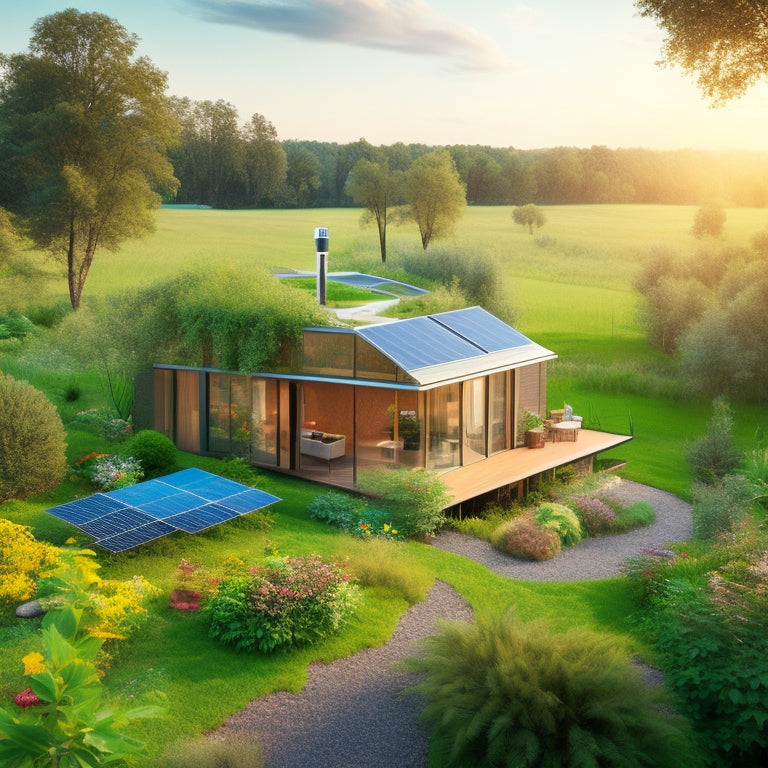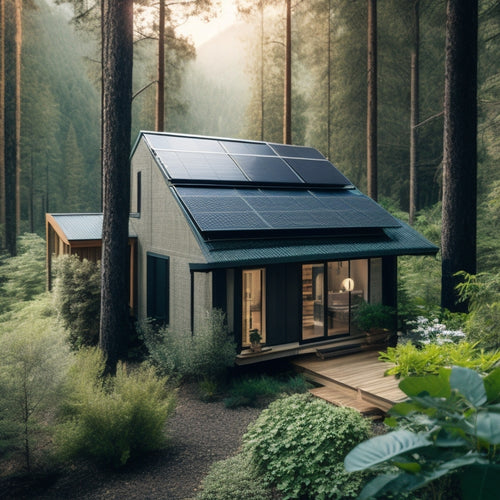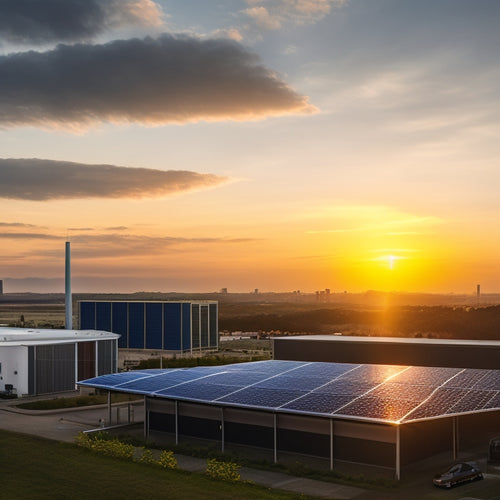
5 Essential Home Energy Independence Design Tips
Share
You're taking the first step towards breaking free from the grid by designing a home energy system that's customized to your specific needs, and that requires a thoughtful, comprehensive approach. To get started, assess your daily energy requirements, optimize system component sizing, and maximize roof space efficiency. Balance your energy storage capacity with the right battery technology, and guarantee code compliance to avoid costly rework. By following these essential design tips, you'll be well on your way to achieving energy independence. Now, dig deeper into the specifics of each tip to reveal the full potential of your off-grid dream.
Overview
- Evaluate daily energy requirements to design a system that minimizes grid reliance and maximizes energy independence.
- Ensure system component sizing is optimized for efficient energy production, storage, and usage.
- Maximize roof space efficiency by optimizing solar panel orientation, selecting suitable roof materials, and utilizing advanced MPPT technology.
- Balance energy storage capacity by selecting suitable battery technologies, considering charge cycles, and ensuring adequate storage for low production periods.
- Ensure code compliance by reviewing local building codes, conducting energy audits, and obtaining necessary permits before installation or upgrades.
Assessing Your Energy Needs
Your path to home energy independence begins with an important step: evaluating your energy needs. This involves understanding your energy consumption patterns, including how much energy you use and when.
To accurately assess your energy needs, it's vital to calculate daily energy requirements by evaluating the wattage and usage hours of each appliance. You'll want to track your energy usage over time to identify areas where you can cut back.
A thorough renewable resource evaluation will also help you determine which sources of energy are available to you, such as solar or wind power. By understanding your energy needs, you can design a system that meets your specific requirements, reducing your reliance on the grid and taking you one step closer to freedom from utility bills.
With this information, you'll be able to create a personalized plan for achieving energy independence.
Optimizing System Component Sizing
How efficiently can you employ renewable energy if your system components are mismatched or undersized? You've assessed your energy needs, now it's time to optimize your system's component sizing for maximum efficiency.
| Component | Efficiency Impact | Integration Considerations |
|---|---|---|
| Solar Panels | 15-20% efficient | Confirm panel wattage matches inverter capacity |
| Inverter | 90-95% efficient | Choose an inverter compatible with panel voltage |
| Battery Bank | 80-90% efficient | Size batteries to meet daily energy needs |
| Charge Controller | 95-98% efficient | Match controller capacity to panel wattage |
| Grid Tie | 95-98% efficient | Confirm system integration for seamless backup |
Maximizing Roof Space Efficiency
Installing solar panels on your roof is an indispensable step towards achieving home energy independence, but it's equally important to maximize the available roof space to generate the most power possible.
To do this, you'll want to optimize solar panel orientation to capture the most sunlight. Selecting the right roof material is also vital, as some materials can increase energy production.
High-efficiency solutions, such as those utilizing advanced MPPT technology maximum power point tracking, can maximize energy collection. Conduct a shading analysis to identify areas where trees or structures may cast shadows, and design your system accordingly.
Additionally, incorporate ventilation strategies to keep your roof cool, reducing heat-related energy losses.
Balancing Energy Storage Capacity
As you've optimized your roof space for maximum energy generation, it's time to turn your attention to balancing energy storage capacity. This vital step guarantees your home remains powered during periods of low energy production.
To achieve this balance, you'll need to select the right battery technologies that align with your energy needs. Consider the charge cycles of each battery type, as this will impact their overall lifespan.
When choosing a battery, look for advanced features like MPPT and multi-stage charging to enhance energy harvesting and efficiency. A deep cycle battery, for instance, can handle more frequent charge and discharge cycles, making it ideal for homes with fluctuating energy demands.
Ensuring Code Compliance Simplified
With your energy storage system in place, it's crucial to confirm that your setup meets local building codes and regulations. Failure to comply can result in costly rework, fines, or even system shut-down. To avoid these issues, you'll need to traverse local regulations and perform energy audits to identify potential compliance gaps.
| Compliance Step | Action Item |
|---|---|
| Review local building codes | Verify with local authorities or consult with a licensed electrician |
| Conduct energy audits | Identify areas of inefficiency and potential compliance issues |
| Obtain necessary permits | Secure permits before commencing installation or upgrades |
| Schedule inspections | Verify your system meets all local regulations and codes |
Frequently Asked Questions
Can I Install a Home Energy System Myself to Save Money?
You can attempt a DIY installation to save money, but consider the risks: improper setup can void warranties and compromise system efficiency, offsetting cost saving benefits - it's essential to weigh the trade-offs before taking on the challenge.
How Long Does a Typical Home Energy System Last?
Your home energy system is like a garden, requiring nurturing to bloom. On average, you can expect a system lifespan of 25-30 years, but regular maintenance is key to maximizing its potential and extending its lifespan, giving you the freedom to thrive off the grid.
Are Energy-Independent Homes More Valuable Than Traditional Homes?
You'll be thrilled to know that energy-independent homes often increase in value, as they offer a desirable asset: freedom from rising energy costs, enhancing your home valuation and appeal to eco-conscious buyers who crave sustainability.
Can I Use a Home Energy System With a Septic System?
You're the skilled conductor of your off-grid orchestra, and a septic system is just one harmonious instrument. Yes, you can use a home energy system with a septic system, integrating them seamlessly for a self-sustaining rhythm that echoes with freedom.
Do Energy-Independent Homes Require Special Insurance Coverage?
You'll want to investigate specialized insurance considerations for your energy-independent home, as standard policies might not cover unique features like solar panels or wind turbines; research policy options that cater to off-grid living and renewable energy systems.
Ready to Buy
You've got the roadmap to energy independence in your hands - now it's time to hit the accelerator! By evaluating your energy needs, optimizing system component sizing, maximizing roof space efficiency, balancing energy storage capacity, and ensuring code compliance, you'll be driving on sunshine in no time. Remember, every watt saved is a watt earned, and with these design tips, you'll be coasting towards a cleaner, greener future. The road to energy freedom has never looked brighter!
Related Posts
-

Why Outdoor Solar Lighting Systems Are Sustainable
Outdoor solar lighting systems are sustainable because they utilize renewable energy, drastically reducing your carbo...
-

Off Grid Solar Batteries
As you shift to off-grid living, you'll rely on high-performance solar batteries to store excess energy generated by ...
-

Advantages of Commercial Solar Battery On-Site Storage
By investing in a commercial solar battery on-site storage system, you can greatly reduce your energy grid dependence...


